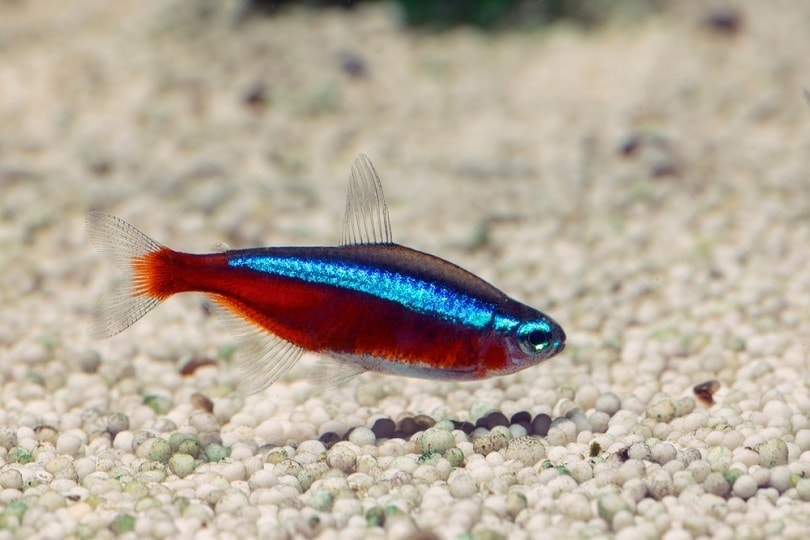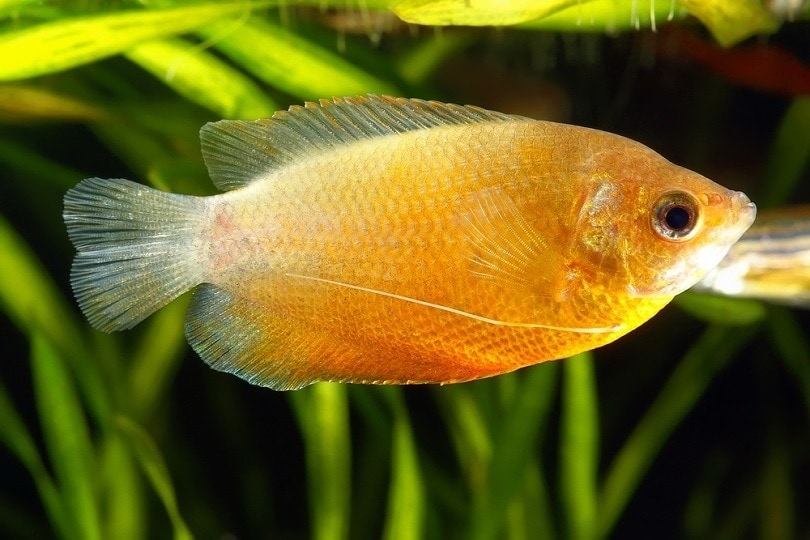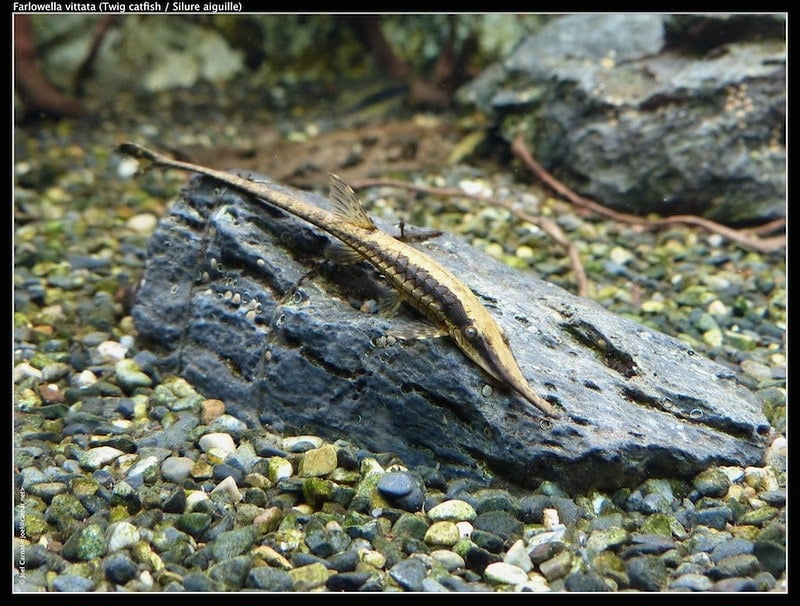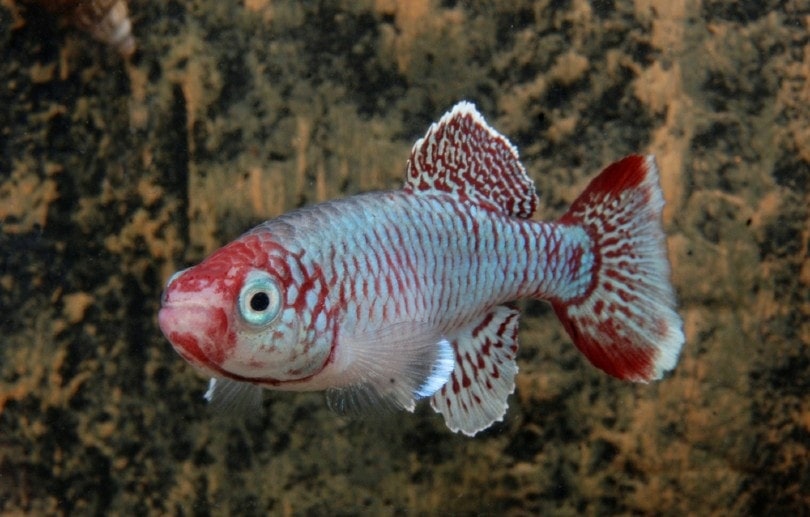12 Great Tank Mates for Killifish: Compatibility Guide 2024

Updated on

There are well over 1,000 species of Killifish worldwide. They are typically found in shallow tropical and subtropical water, which can be still or moving. Most Killifish are freshwater fish, but some species live in saltwater and brackish water.
Unfortunately, these beautifully colored fish don’t have long lifespans. It might only be several months—at least in the wild—but they have an average lifespan of 3 months to 5 years in captivity. They come in a wide variety of patterns and colors, and they average in size between 1–4 inches, although many of the larger species can grow to 6 inches.
If you’ve been thinking of adding a few tank mates to your aquarium to keep your Killifish company, we go over the most compatible fish for your pet. The size of your Killifish is definitely a factor, so we focus on smaller fish for the smaller (and more average-sized) Killifish.
The 12 Great Tank Mates for Killifish
1. Celestial Pearl Danios (Danio margaritatus)

| Size: | Up to 1 inch |
| Diet: | Omnivore |
| Minimum tank size: | 10 gallons |
| Care Level: | Medium |
| Temperament: | Peaceful |
The Celestial Pearl Danios are also known as Galaxy Rasboras. They are peaceful fish that are small in size, which makes them good tank mates for your Killifish. They have a lifespan of about 3–5 years and enjoy constantly moving along the lower parts of the tank.
2. Zebra Danio (Danio rerio)

| Size: | 2 inches |
| Diet: | Omnivore |
| Minimum tank size: | 10 gallons |
| Care Level: | Easy |
| Temperament: | Peaceful |
The Zebra Danios are easy to look after and are peaceful freshwater fish. They make great fish for beginners and enjoy swimming in a fast-moving school of fish. They are a silvery-gold color, with five blue “zebra” stripes that run along the length of their bodies.
3. Guppies (Poecilia reticulata)

| Size: | 0.6–2 ½ inches |
| Diet: | Omnivore |
| Minimum tank size: | 5 gallons |
| Care Level: | Easy |
| Temperament: | Peaceful |
There are hundreds of varieties of Guppies that come in a wide variety of colors. They are sometimes known as Rainbow Fish because of their vivid patterns and colors. They are great fish for beginners, and they are not aggressive toward other fish.
4. Neon Tetras (Paracheirodon innesi)

| Size: | 1.5 inches |
| Diet: | Omnivore |
| Minimum tank size: | 10 gallons |
| Care Level: | Easy |
| Temperament: | Peaceful |
The Neon Tetra is a popular, energetic, colorful fish and prefers to swim around the middle level of the aquarium. They are not usually aggressive, and they share the same kind of diet as the Killifish.
5. Cardinal Tetras (Paracheirodon axelrodi)

| Size: | Up to 2 inches |
| Diet: | Omnivore |
| Minimum tank size: | 20 gallons |
| Care Level: | Easy |
| Temperament: | Peaceful |
The Cardinal Tetra is brightly colored. They have a bright blue top and are bright red along the bottom. They are quite hardy fish that are easy to care for and are peaceful. They prefer swimming in the middle to the top levels of the tank.
6. Cockatoo Dwarf Cichlid (Apistogramma cacatuoides)

| Size: | 2–3 ½ inches |
| Diet: | Carnivore |
| Minimum tank size: | 30 gallons |
| Care Level: | Moderate |
| Temperament: | Mildly aggressive |
The Cockatoo Dwarf Cichlid is only truly territorial when breeding and usually with their own species, so they typically do well with other species. They are otherwise pretty shy and mellow and spend time hiding in dark places and in plants.
7. Peppered Cory Catfish (Corydoras paleatus)
| Size: | 2–3 inches |
| Diet: | Omnivore |
| Minimum tank size: | 10 gallons |
| Care Level: | Easy |
| Temperament: | Peaceful |
The Peppered Cory is a peaceful catfish and is one of the more popular Corydoras. They are a light brown to bronze color with gray patches and speckles. They can live for around 10 years, and you might find them occasionally gulping in the air on the surface, which is normal behavior. They scavenge for food along the lower parts of the tank and are easy to look after.
8. Honey Gourami (Trichogaster chuna)

| Size: | 3 inches |
| Diet: | Omnivore |
| Minimum tank size: | 10 gallons |
| Care Level: | Easy |
| Temperament: | Peaceful |
The Honey Gourami makes a great beginner fish because they are peaceful and hardy. They tend to be rather shy and prefer the middle and surface levels of the aquarium. They are also commonly called “sunset” because they are a golden, honey-like shade. The Honey Gourami catches prey by squirting water at it, so it drops into the water.
9. Blackline Rasbora (Rasbora borapetensis)
| Size: | Up to 2 ½ inches |
| Diet: | Omnivore |
| Minimum tank size: | 20 gallons |
| Care Level: | Moderate |
| Temperament: | Peaceful |
The Blackline Rasbora is a silver fish with a black or dark brown stripe that runs across the body underneath a gold stripe and a flash of bright red along the caudal tail. They are hardy and active fish that do well when sharing a tank with other peaceful schooling fish.
10. Rubber Lip Pleco (Chaetostoma milesi)
| Size: | 7 inches |
| Diet: | Omnivore |
| Minimum tank size: | 30 gallons |
| Care Level: | Easy |
| Temperament: | Peaceful but territorial |
The Rubber Lip Pleco is a hardy fish that is a bottom feeder, so you’ll typically find them on the bottom of the tank. They are gray in color with black stripes or spots that cover their bodies. They can be territorial, but they tend to ignore other species of fish otherwise.
11. Twig Catfish (Farlowella vittata)

| Size: | Up to 9 inches |
| Diet: | Herbivore |
| Minimum tank size: | 20 gallons |
| Care Level: | Medium |
| Temperament: | Peaceful |
There are around 37 species of the Twig Catfish, but the Farlowella vittate is the most common in aquariums. They can be rather large and are long, thin, and brown, resembling a twig. They are quite shy and will do best with peaceful tank mates.
12. Asian Stone Catfish (Hara jerdoni)
| Size: | 1.21.4 inches |
| Diet: | Omnivore |
| Minimum tank size: | 10 gallons |
| Care Level: | Medium |
| Temperament: | Peaceful |
The Asian Stone Catfish is also sometimes called the Anchor Catfish because they somewhat resemble an anchor. They are small and are a light or dark brown hue, or they can be reddish-brown or gray. They are nocturnal fish that are shy and spend time hanging out at the bottom of the tank
What Makes a Good Tank Mate for Killifish?
Killifish are schooling fish that are quite peaceful except for when around other Killifish males. They do well with other small fish species that are also calm and share similar water parameter requirements.
Good tank mates for your Killie will depend on what specific species you have. There are over 1,000 different kinds of Killifish, which all come in different sizes and temperaments. You need to base your choices in tank mates on your Killie’s size — the tank mates need to be roughly the same size.
What Swimming Levels Do Killifish Prefer in the Aquarium?
One important aspect of the Killifish is their ability to jump. Your aquarium must be covered with a lid without any gaps, as Killies can jump through even small spaces.
Killies are energetic and agile swimmers that prefer to swim in the lower levels of the aquarium. When selecting tank mates, aim for a variety of fish that will swim at all three different levels.
Water Parameters
Killifish need slow-moving water, so you’ll need to set up the water parameters to closely resemble their natural environment.
- Temperature: 72°F–75°F
- Water Hardness: 122–162 ppm
- Water pH: 6–7.2 (7 is ideal)
You should use an aquarium heater to regulate the temperature, along with a filter. These water parameters will also depend on what species of Killifish you have, so you’ll need to double-check the conditions for your Killie.
Size
The size ultimately depends on what kind of Killifish you have. Most Killies are slender and shaped like pike, so they are excellent swimmers. Other species are cylindrically shaped, and you’ll see a variety of different sizes of fins.
The average Killifish might range around 1–4 inches, but others can grow as large as 6 inches. One of the smallest species is the Hummingbird Lampeye, which is less than an inch, and one of the largest is the Gulf at 7 inches.
Aggressive Behaviors
Killies are typically quite peaceful, but they are known to show aggression toward other male Killifish. Females tend to get along with each other in a community tank.
Different species of Killifish might show more aggression than others. For example, the Blue Gularis and the Golden Wonder are both popular species, but they tend to be more aggressive than other Killies. They tend to do better with other equally “feisty” fish. Always research what species of Killie you have before adding any tank mates.

Top 3 Benefits of Having Tank Mates for Aquarium Killifish
1. School
Killies are schooling fish when in the wild, so they do best when with other schooling fish.
2. Health
If a Killie is alone, it will become stressed, so being with other fish gives them a sense of well-being. Being with a school keeps them healthy.
3. Peaceful
Since male Killies can be aggressive with other males of their own kind, finding different fish as tank mates will give them their school without worrying about aggression.

Aquarium Set-Up
If you’re planning on having more than one fish, you’ll need a 20-gallon tank at an absolute minimum. The more species you add, the larger the aquarium needs to be. The tank can be shallow because Killies are accustomed to living in shallow water, but this also depends on the tank mates that you choose.
You need low lighting, and the substrate should be dark, such as dark gravel with sand, as it will mimic their natural habitat. Make sure you have a tight lid!
Conclusion
Killifish aren’t the most well-known aquarium fish, but they should be! They are easygoing fish with all kinds of colors to choose from. They make great tank mates for any other similarly sized and peaceful fish.
Just be sure to research your species of Killie before you go shopping for any tank mates. We hope that you end up with a gorgeous aquarium full of beautiful and vibrant fish.
You might be interested:
Featured Image Credit: jijo b, Pixabay













